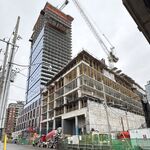There are some interesting comments on this on the Spacing Wire right now.
spacing.ca/wire/?p=719
Non-politically though, that sprung dance floor, to my surprise, wasn't sprung at all. It was rot, and a frame that "gave". As it aged, it gave more, feeding the legend:
--
http://eye.net/eye/issue/issue_05.04.06/city/stroll.html
Eye - May 4, 2006
Stroll
The end of Toronto
There is, fittingly, a Coffee Time at the end of Toronto. It's in Parkdale, where Queen, King, Roncesvalles and The Queensway terminate in an impossible urban tangle of streetcar tracks and wires. Somewhere up in Vaughan -- or, worse, Aurora -- the city starts to come together, rolling south, getting thicker and less suburban, acquiring subways, streetcars, more people and then suddenly nothing. A freeway followed by Lake Ontario wilderness.
It's a good place for the Katyn Memorial, a monolithic slab of steel cracked in half, just east on King. It was built to remember 15,000 Polish prisoners of war who vanished in 1940 from camps in Russia. Over 4,000 were later discovered in mass graves at Katyn, murdered by the Soviet State Security police.
Parkdale wasn't always estranged from its lake. Building the Gardiner resulted in the destruction of 170 homes, as most of Parkdale's north-south streets ended as wharves on the lake. Parkdale was posh and mansion-filled (and many streets are slowly poshing up again through gentrification). Adjacent was the Sunnyside Amusement Park -- "the poor man's Riviera," complete with dogs dressed up in girls' clothes and horses that dove head-first into the lake -- which was also removed to make way for the Gardiner.
All that's left of this era is the Sunnyside Bathing Pavilion and the Palais Royale, a lonely lakefront outpost despite being only a two and a half minute walk from two major streetcar lines over the Roncesvalles pedestrian bridge.
Built in 1889 as Dean's Sunnyside Pleasure Boats, the original frames for the boat doors are still visible in the Royale's basement. When it was converted into a dance hall in 1922, all the usual big band names came -- Tommy Dorsey, Duke Ellington, Count Basie -- and the place was regularly packed. In 1988, Basil Dolan recalled, "There were so many people here that you weren't allowed to break into jive. You had to stay close or the bouncers would come over and warn you. 'No breaking or you're out.'"
But big bands fell out of style, and the place went downhill with only occasional shows, like the "secret" Rolling Stones gig in 2002, when a temporary air conditioner was installed on stage to keep the millionaires from overheating.
Palais Royale is currently undergoing $3 million in renovations, though, and it will reopen in June with regular live-music bookings and a huge lakeside patio. The renovation has also busted one of Toronto's long-held myths: the legendary sprung dancefloor wasn't sprung at all -- the floor just "gave" a little. No matter, legends aren't always built on the truth, and it will be good to have the Palais Royale back.
SHAWN MICALLEF IS AN EDITOR AT SPACING MAGAZINE, NEW ISSUE IN STORES NOW. STROLL APPEARS EVERY TWO WEEKS.






